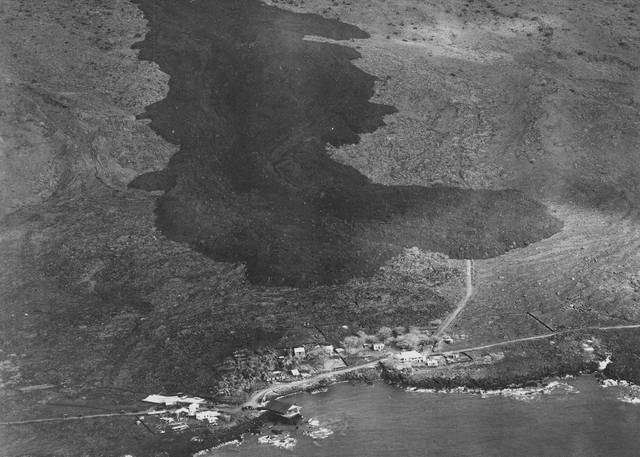With the hustle and bustle of the holidays upon us, Hawaii Island residents are likely giving little thought to the volcanic terrain beneath their feet. And that’s all right — for now.
But with two of the world’s most active volcanoes — one erupting nearly non-stop for more than three decades (Kilauea) and the other stirring for over two years (Mauna Loa) — volcano awareness should never be far from our minds. So, as you ring in the New Year, we hope you’ll add “learn more about my volcanic home” to your list of resolutions.
You can begin fulfilling that resolution in January — Hawaii Island’s ninth annual Volcano Awareness Month.
Just as we have since 2010, when Volcano Awareness Month was established by mayoral proclamation, USGS Hawaiian Volcano Observatory (HVO) scientists will offer a series of programs in January to help keep residents and visitors informed about Hawaiian volcanoes. All programs are open to the public, and no reservations are required.
Four talks will be presented in Hawaii Volcanoes National Park, with weekly “After Dark in the Park” programs held at 7 p.m. in the Kilauea Visitor Center auditorium. The first talk, on Jan. 9, provides a brief review of the early history of Kilauea Volcano’s ongoing East Rift Zone eruption followed by an in-depth look at lava flow activity during the past year.
The next “After Dark in the Park” program, on Jan. 16, features a presentation on Kilauea Volcano’s current summit eruption, including a recently released USGS video that recounts the formation and growth of the summit vent and lava lake in Halemaʻumaʻu. The following two programs address the surprising discoveries gleaned from the collection of volcanic ash produced by Kilauea’s summit lava lake and the volcanic geology along Saddle Road, on Jan. 23 and Jan. 30, respectively.
Hilo’s Lyman Museum will also promote volcano awareness in January. On the evening of Jan. 8, and again on the afternoon of Jan. 9, the museum will host an HVO talk about Kilauea Volcano’s 1955 East Rift Zone eruption. During this 88-day-long eruption, lava from at least 24 different vents buried sections of every public road in the lower Puna district, impacting communities from Kalapana to Kapoho — reminders of why island residents need to understand how Hawaiian volcanoes work and the hazards associated with them.
Mauna Loa, the largest active volcano on Earth, will also be the topic of conversation during three Volcano Awareness Month programs. But instead of a single speaker talking to a seated audience, the format of these events will be community “open houses.”
Promoted as “Mauna Loa: Let’s Talk Story,” these open houses are a collaborative effort of the Hawaiian Volcano Observatory, Hawaii County Civil Defense, Hawaii Volcanoes National Park, and the University of Hawaii at Hilo. Staff from each of these agencies will set up informative displays that answer frequently asked questions about Mauna Loa and will be on hand to answer any additional questions from the public.
Residents and visitors are invited to stop by the open houses to learn more about Mauna Loa and “talk story” with scientists, public safety officials, and park rangers. The events will be held on the UH-Hilo campus on Jan. 13 (noon-3 p.m.), in the Ocean View Community Center on Jan. 17 (6-8 p.m.), and in the Konawaena Elementary School cafeteria on Jan. 27 (noon-3 p.m.).
Details, including the dates, times, location maps, and descriptions of all 2018 Volcano Awareness Month programs are posted on HVO’s website at https://volcanoes.usgs.gov/hvo/). You can also email askHVO@usgs.gov or call (808) 967-8844 for more information.
Whether you’re a longtime resident or a recent arrival on the island, January will be a good time to enhance your knowledge of Hawaiian volcanoes. Understanding the eruptive histories, current status, and associated hazards of our island’s active volcanoes, and knowing how to stay safe during an eruption are essential to living in harmony with our volcanic environment.
Please join us in January to learn more about Kilauea and Mauna Loa, and to meet some of the HVO scientists who monitor and study them, as well as our partner agency colleagues. Until then, we wish you safe and happy holidays!
Volcano Activity Update
This past week, Kilauea Volcano’s summit lava lake level fluctuated with summit inflation and deflation, ranging about 99-154 feet below the vent rim. On the East Rift Zone, the 61g lava flow remained active downslope of Pu’u ‘O’o, with scattered breakouts on the pali and coastal plain, but no ocean entry. The 61g flows do not pose an immediate threat to nearby communities.
Mauna Loa is not erupting. Small-magnitude earthquakes occurred beneath the summit caldera and upper Southwest Rift Zone at depths less than 3 miles and at rates similar to the past few weeks. A few deeper earthquakes were scattered beneath the volcano’s southeast and west flanks at depths of 3-8 miles. GPS and InSAR measurements continue to show deformation related to inflation of a magma reservoir beneath the summit and upper Southwest Rift Zone. No significant changes in volcanic gas emissions were measured.
One earthquake with three or more felt reports occurred in the Hawaiian Islands this past week: a magnitude-2.9 earthquake was recorded at 12:35 p.m. Nov. 30 about 9 miles southwest of Kailua-Kona at a depth of 24 miles.
Visit https://volcanoes.usgs.gov/hvo for past Volcano Watch articles, volcano updates and photos, recent earthquake info, and more. Call for summary updates at (808) 967-8862 (Kilauea) or (808) 967-8866 (Mauna Loa). Email questions to askHVO@usgs.gov.
Volcano Watch is a weekly article and activity update written by U.S. Geological Survey Hawaiian Volcano Observatory scientists.



